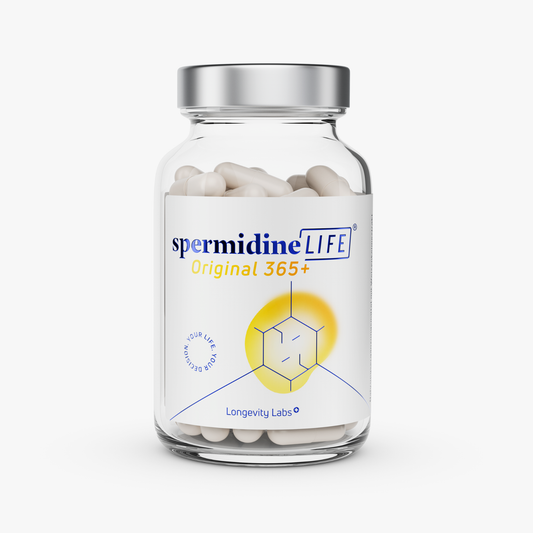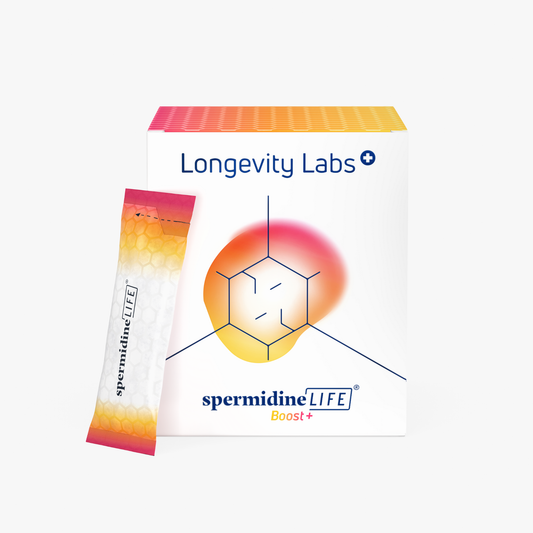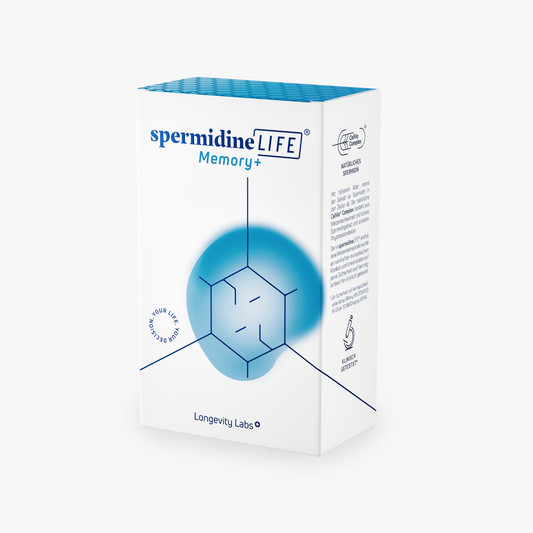
Our brain cells and neurogenesis
Memory,Science, TLL LongevityLabsEveryone wants to keep their gray matter fit and healthy. But how do you do that? We'll show you what makes brain cells special, what the latest research has told us about them, and how you can support them in their work.
The brain, or cerebrum in technical terms, is the seat of our gray matter. Although it only accounts for about 2% of our total body weight, it claims about 20% of our basic metabolic rate and oxygen consumption. That's because it's made up of about 100 billion nerve cells - also called neurons - and, as the central nervous system, it controls a seemingly endless array of functions.
The brain and its functions
In simplified terms, the brain can be divided into four main areas that perform different tasks:
- The cerebrum in the center is formed by two connected hemispheres or hemispheres and is probably the best known part of the brain. As a communication center, it connects all organs, organ systems and tissues with each other.
- The diencephalon consists of the thalamus, hypothalamus, subthalamus and epithalamus. From there, information from our sensory organs is transmitted to and from the cerebrum, numerous physical and mental life processes are controlled, and sleep-wake control is partially regulated.
- The cerebellum is responsible for balance, movements and their coordination and plays a role in language acquisition and social learning.
- The brain stem is the oldest part of the brain and consists of incoming and outgoing nerve fibers. It processes incoming sensory input and outgoing motor information, regulates automatic processes such as heartbeat, breathing or metabolism, and controls important reflexes such as closing the eyelids, swallowing and coughing.
Up to this point, it should be clear how much influence the brain really has on our existence. Through the incoming and outgoing nerve pathways, it is connected to the entire body as the main computer to perform the tasks listed above. The length of the nerve pathways thus created is about 5.8 million kilometers. This corresponds to 145 times the circumference of the earth! But how do these connections come about? And how does our brain manage to coordinate all these tasks?
Our brain cells, the neurons
Well, it all starts with the nerve cells of our central nervous system: the neurons. In addition to a nucleus and a cell body, they also consist of nerve cell processes called dendrites. These can be up to one meter long and a single nerve cell can use them to connect with up to 30,000 other nerve cells.
In addition, neurons are capable of establishing connections to other nerve cells via so-called axons. They form a communication network in order to transmit messages effectively and quickly. To do this, they use electrical charges at a speed of 0.001 meters per second and can thus communicate about 500 times per second.
When the axons of two neurons connect, the resulting connection is called a synapse. However, these synapses do not only connect the direct nerve cells with each other, but also establish contact to more distant parts of the body via the network. By means of chemical messengers - so-called neurotransmitters - the brain cells can exchange information. In this way, our brain can communicate directly with our little toe.
The more synapses a neuron now has, the more information it can transmit. In total, there are over 100 trillion synapses in our brain. They manage around 1013 analog computing operations per second. That's quite a feat for our main computing center, we think.
By the way, the neurons are protected by the so-called glial cells - also cells of our brain. They also provide electrical insulation by covering the neurons and play a key role in the transport of substances and the exchange of fluids. But why is all this important?
Neuronal decay
Well, as we age, the number of neurons unfortunately decreases continuously, so that by the time we are 80, we have already lost around 30% of our neurons. One of the reasons for this is that the unusually high average metabolic rate in the brain also produces an unusually high amount of waste, some of which is harmful to our brains.
Although our brain has its own clean-up command in the form of the system that flushes out harmful substances, unfortunately each and every one of us takes dozens of actions every day that harm our neurons. Yes, we even ensure that neuronal decay and thus cognitive loss occur.
You are not aware of any guilt? Well, if we now tell you that these bad habits include the consumption of cigarettes or alcoholic beverages, as well as poor nutrition, insufficient sleep or tension and stress, then you will probably quickly see the light. Because, as we have often talked about, these habits damage our cells, and therefore our brain cells, the neurons.
Bad news, isn't it? After all, we all already have one or the other year of sins behind us. But don't worry, we won't just leave you with this bad news, of course. Because the latest findings of science bring hope.
The secret of neurogenesis
Scientists have been able to prove that our brain cells are not - as previously assumed - created at birth and do not divide afterwards. On the contrary, the adult brain can also form new nerve cells into old age, as a team led by María Llorens-Martín from the Autonomous University of Madrid was able to show in a study in 2019.
For this purpose, the researchers examined tissue samples of the brains of 58 deceased patients up to 87 years of age and discovered immature - i.e. newly formed - neurons in the hippocampus there. This makes it clear that the regeneration process or the formation of new nerve cells - so-called neurogenesis - decreases with age, but does not stop.
Neurons develop - like most of our cells - thanks to the cellular competence of renewal from stem cells. You can read more about this here here. This was also confirmed by neuroscientists at the University of Pennsylvania, as they reported in the journal "Cell". They were able to identify those stem cells in mice from which new nerve cells develop.
"We were able to show that it is a lineage of stem cells in the hippocampus that is present from the embryonic to the adult brain and continuously forms neurons," explained study author Hongjun Song. "These new, immature neurons are more flexible than older ones. They can make connections more easily. That's important in learning, memory and mood. The results suggest that our brains are capable of constantly improving, adapting and integrating new cells into their circuits."
Around 1,400 new cells are thought to be created in the hippocampus each day as a result. With these, about one-third of all brain cells are exchanged over the course of our lives. Ludovic Telley and his colleagues at the University of Geneva have investigated exactly how this happens. Using mouse embryos, they investigated how different neurons are formed. The result: neocortical stem cells go through different life stages. In each stage, a different genetic program is unwound and thus a different type of neuron is formed.
According to their research, a certain protein complex - the so-called PRC2 complex - is responsible for this. It triggers the different stages and stimulates the production of neurons. Co-author Nicole Amberg of the Austrian Institute of Science and Technology in Klosterneuburg said, "We now have a clearer idea of how neural stem cells form the right type and number of neurons during cortical development."
Interestingly, the stem cells become more receptive to environmental influences over time, the study also found. Thus, the gene programs that are later activated are increasingly dependent on external signals as well. This thus also applies in general to neurogenesis in adults. It is influenced both by genetic information and by external factors. What does this mean in concrete terms? We can inhibit or stimulate our neurogenesis!
Stimulate neurogenesis specifically
We have already explained that we can have a negative impact on our brain cells with our habits. But the good thing is that we can also influence them and their renewal in a positive way. Studies in mice have shown that physical activity contributes to the formation of neurons.
And although mouse studies can't be extrapolated one-to-one to humans, neuroscientist Sandrine Thuret of King's College London is convinced that neurogenesis can be similarly influenced in humans. She cited learning something new, exercise, sex and a balanced diet as positive stimuli for neuron formation. Whereas stress, lack of sleep and alcohol decrease neurogenesis. Their claims are also partially supported by studies from 2011 and 2016, which found that these factors have a positive and negative effect on memory, respectively. But whether this is actually due to neurogenesis remains to be determined.
The Pennsylvania researchers, who identified those stem cells in mice that are capable of neurogenesis, now want to test whether they are also found in other mammals and especially in humans. If so, they and science would be a big step closer to being able to use the findings therapeutically. Co-author Guo-Li Ming said, "The study gives clues about what keeps the brain young, how to preserve memory and learning ability. If you can harness this mechanism, you might be able to regenerate or repair parts of the brain."
But it will be some time before that happens. What you can do for so long is not only stimulate your neurogenesis, but also make sure your brain cells stay fit and active, and thus not part of the 30% or so of neurons we lose as we age.
Keep your brain cells active
Active brain cells, are good brain cells! We've all heard the saying, "A rolling stone gathers no moss," and especially when it comes to our neurons, it couldn't be more apt. Scientists have shown that active - that is, trained - brain cells bring various benefits:
1. active neurons receive more blood.
Active brain areas need more energy, more oxygen, and more glucose, so they get better blood flow to meet those needs. Consequently, when you activate a part of your brain - for example, through brain training - more blood flows to that area, and with it more oxygen. Since neurons are very dependent on oxygen supply, this is a big plus. If they receive too little oxygen, they die prematurely. 2.
2. active neurons have more connections.
As explained above, a neuron connects to other neurons through the dendrites. But the fact is that active brain cells connect more often than inactive ones. Thus, they remain an active part of the neural network. The larger a cell's neural network is, the more chances it has to be activated and survive in the long run.
3. active neurons produce more "maintenance substances".
Active neurons are bound by what is called nerve growth factor (NGF) - a protein - and marked as active, differentiated and responsive. This is a good thing, because it makes them produce even more NGF. A positive vicious cycle is created to strengthen the cell.
4. active neurons stimulate the migration of beneficial cells.
As described above, the stem cells of our hippocampus form new brain cells thanks to neurogenesis. If we now keep our neurons active, these new cells can migrate to other areas of the brain - depending on where they are needed. After a brain injury, for example, the new cells move to the impaired areas and can mimic the functioning of the neighboring cells there. In this way, they help to partially restore the damaged area.
Impressive, isn't it? To keep your brain cells active, cleared of debris, and supplied with all the essential micronutrients, you should also nourish them with spermidineLIFE® Memory+ support.1,3,5 This provides you and your neurons with an innovative combination of natural wheat germ extract with high spermidine content, Brahmi powder, saffron extract and the micronutrients vitamin B1 - also called thiamine -, zinc and iron. Or in short: important brain-active micronutrients that your gray cells need.1,3,5






